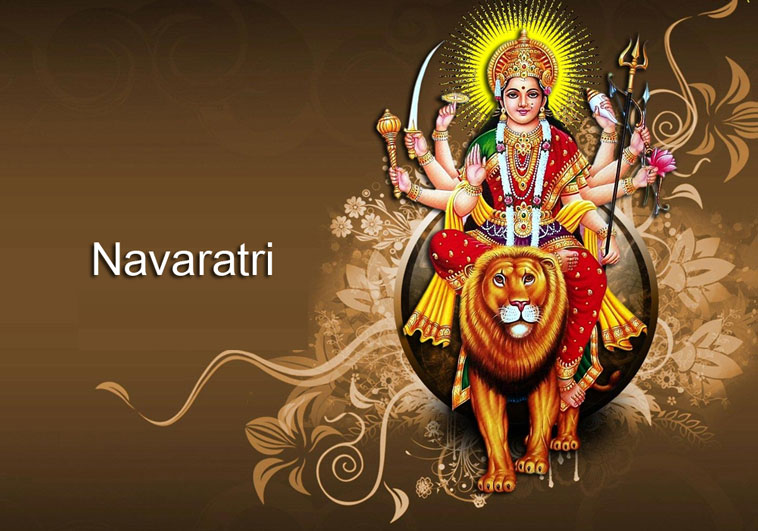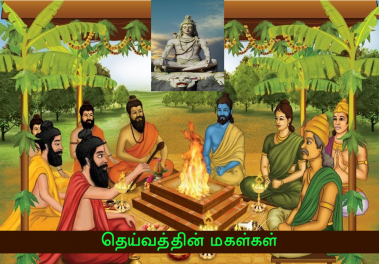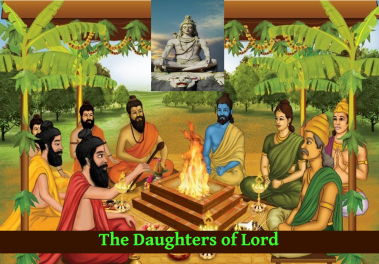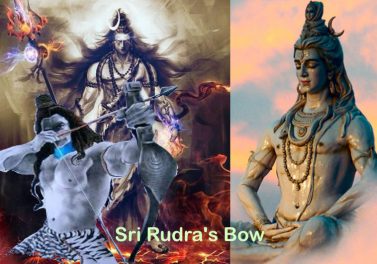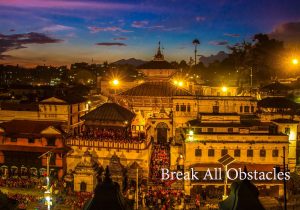NAVARATHRI
Conversation with Aiya (2)
‘Srinivas, Can you please hold the ladder for me’, I asked, as I was climbing up to the loft. I needed to take down the wooden planks and the boxes of dolls from the loft to set-up the golu for the forthcoming Navarathri.
Uma and children were out shopping and I was given the task of getting things ready for the Navarathri celebrations. I was not complaining about the task as I enjoy the preparation for Navarathri.
Srinivas our nephew had come from Sweden, with his friend David. As part of their final year medical degrees, they were planning to spend some time in the University Hospital, London. Both were sitting in the living room, when I called out for help.
‘Yes uncle’, said Srinivas and sprung into action. He held the ladder as I climbed. David too was at his side to give a hand if needed.
‘Few minutes Aiya’, I said loudly for Aiya to hear, who was sitting in the living room, reading his book.
Aiya had also come for a brief visit.
If you had not heard about Aiya, you should now.
Aiya is a remarkable and a simple man. A scientist by qualification and a consultant by profession, Aiya is a good friend, whom I know more for his unique thoughts and deep insights into spirituality. He has been a comforting companion for us, many a times, sharing his perspectives on life-matters that are timely and helpful. There is more to talk about him.
I climbed the ladder and opened the loft door. At once, there was the glitter of autumn Sun seeping through the hiatus on the roof, lazily making the loft, a dark space littered with scattered bright stars. While it was enchanting, ‘I must fix the roof before the winter’ I thought, as I slowly brought down the cardboard boxes of dolls and the pile of wooden planks.
Golu steps could be purchased or fabricated professionally. But pride in my DIY skills mean, which according to my wife, more of ‘damage-it-yourself’ rather than ‘do-it-yourself’, that I must do all by myself. That I did. A fabulous 5-step golu-padi, made-up of some garden decking and wooden planks, has been in use for the past four years. For each year, I simply have to clean the planks, assemble and secure in the allotted place.
‘I must do this before Uma returns’, I thought; if time permits, I must also take out the dolls from the boxes and clean them.
Srinivas was watching quietly.
As he was laying the planks on the floor, counting ‘one, two, three, four and five…. Are there 5 steps?’ he asked.
Before I could answer, he continued, ‘Why is it always an odd number of steps? I remember my grandma in Chennai also used to set up 7 steps or 9 steps for the golu’.
‘Perhaps it is just the custom’, I said.
‘Odd number of steps mean there is a naturally a middle or centre, Isn’t it? Centre is an important concept.’
‘In what way?’ asked David.
I have seen David taking curious and deeper interests in the Indian traditions, perhaps because of his constant companionship with Srinivas. Given a chance, David would happily marry an Indian girl, I thought.
‘Well, in the heart of golu, there is always the main deity. With odd number of steps, there is a prominent centre-place’, I said, watching Aiya who was also looking-up, after putting down the book he was reading.
‘Correct. It is called hridaya-stan or central place’, said Aiya.
‘In Sanskrit the word hridaya means the centre. It is not the physical heart but the logical centre.’
Aiya continued.
‘If you notice, when there is odd number of steps, there is a clear centre or hridaya-stan, where usually, a lamp is lit or a kalasam with the face of Ambal is placed.’
‘What is kalasam’, asked David.
I had just opened a box and there was the silver pot, with the face of Goddess embellished on one side.
I showed him.
‘See, this is kalasam, a holy pot which is filled with water or grain of rice, flower etc. and also crowned with a coconut as the centre piece of worship’.
I knew this too, but to hear from Aiya would be a different experience.
Aiya usually does not speak unless spoken to. Now that he had intervened, he was going to give us some deeper insights, I thought.
I therefore said to Aiya, ‘It is also our tradition, is it not, Aiya? No one keeps even-number of steps’.
‘Yes… but what is tradition….!’ he paused.
‘It is after all, reasoning only, but often overwhelmed by personal emotions and practices. As time goes, we all bring changes to what we had inherited from our elders, perhaps to suit our changing needs.’
He paused for a while and said, ‘We are also clever to rationalize such changes’; then he continued.
‘There is nothing wrong in changing, as long as the true meaning or the tatparya is not compromised’.
‘What is the tatparya or the inner meaning of golu? I thought it is just the display of dolls to celebrate’, asked Srinivas.
I too thought likewise. Navarathri or any festival in our tradition brings immense joy and fun. Most of us always welcome these celebrations. Yet, display of dolls and worshipping them, somehow did not make much sense, I thought.
‘Yes, Navarathri is both a celebration and worship’, said Aiya.
‘Have you actually observed what sorts of dolls are kept in the golu or how those dolls are arranged?’
I interrupted.
‘Well, it is not just gods’ idols; we keep all sorts of dolls: man, woman, animals, toy utensils etc.’
‘In our house, my mother even puts the dolls that I made with LEGO bricks in the golu’, said Srinivas.
Aiya looked at me as I continued.
‘I remember how my mother always used to set-up nine-step golu. There were lots of dolls, filling all those steps; but in the middle, always there would be the kalasam with Ambal’s face.’
‘Can you describe what used to be on the lowest step’, asked Aiya.
‘Well, the golu-padi would be placed in the hall and on the floor, at the edge of the lowest step, we used to build a small pond and fill with water. My mom would grow sprouts and plant those around the pond. My brothers and I used to put up saplings and all sorts of things around the pond and make it like a real pond in the woods. ‘
I paused for a while as the thoughts of those golden days absorbed my moments.
‘I remember, once I caught couple of small fish from the river and let those into the pond. My mom, while decorating the golu, was startled when a fish jumped inside the pond. Of course, after a gentle reprimand and the promise that I would return them safely back to the river, she too enjoyed their company. She did teach me how to feed the fish with rice flakes….’
I closed my eyes as if to arrest the sweet memories. My heart was filled with intrinsic joy.
Srinivas asked.
‘Then?’
‘Well, normally in the lowest step, we keep the dolls of animals, tools etc. And the step above, we keep the idols of soldiers, kings, priests….’
Srinivas added. ‘Did you also have the dolls of Chettiar and Wife, the ones with nodding heads?’
‘Yes, who will miss those…’, I said.
‘In the step above, we keep the dolls of various angles, rishis, gods etc.’, I said while opening up the doll-boxes.
There was the dasavathara set (ten incarnations of Lord Vishnu).
‘This is a definite one’, I showed the dasavathara set.
‘Yes, we keep this on a step and above this, we would place lots of other gods’ idols. Once all the dolls are placed on the steps, we will make space in the middle; at this centre goes the kalasam.’
Aiya looked at us.
‘There is an order here. Can you see..?’
‘Yes’, I hesitantly replied.
‘Golu represents our loka – our universe of experiences. At the base is the world of objects and environment, in the forms of trees, water, mountains etc. Nature is an essential part of our experiences. Then there are lower life forms like the birds, fish and animals which also form an important part of our life.’
‘Yes’, I said.
‘Above these lower life forms is the human race. Do you see? ‘, asked Aiya.
‘In golu, traditionally human race is depicted in various roles of varna dharma such as rulers and leaders of the society, priests and teachers, traders and farmers etc. For example, the Chettiar doll represents the trading aspects of our nature. Almost every human emotion is depicted through the dolls; there is wedding, prayers, children, young and old. ‘
‘Yes, yes’ said I.
‘Above these human roles, there are idols that represent the super human or divine characters.’
‘Like the rishis, seers, and the incarnations of God into many different forms, correct?’ I asked.
‘Yes, And above those are various manifestations of God. Of course, the form of Lord Ganesh is always placed on top of the steps, as you all know that worship of Lord Ganesh is the foremost aspect of all our rituals’ said Aiya.
After a pause, he continued, ‘These are not rules but a general principle’.
‘The point of all these is…?’, questioned Srinivas.
‘The point is to show that golu represents the very universe that we all live in, with all its varied names and forms. More importantly, to show that in the diversity, there is Atma, as the unifying force’ said Aiya.
He then continued after a momentary silence.
‘The indwelling light that embeds in all living beings is the Self, the Atma. It is the light that is in the centre. It is also the Universal-self, the Paramatma’.
David asked ‘What about the kalasam?’
‘Well, the kalasam may be placed in lieu of the lamp. It also signifies the principle of Atma only. The outer body of the kalasam represents human embodiments, the auspicious fillings such as grains, flowers, turmeric etc. represent the qualities of our embodiments and the void space inside the kalasam represents the unconditional Self’, replied Aiya.
While taking out the dolls from the box, Srinivas and David were also taking in, lot from the conversation with Aiya, I thought.
I continued, ‘Aiya, so the point is that there is unity in diversity’.
‘Yes, it also means that there is an order of evolution and all embodiments – from a state of minerals or lower life forms to humans to gods – have the indwelling Atma.’
David turned to Aiya and said, ‘Very interesting Sir. Please tell me… Are we the light, or the body carrying the light?’
There was silence.
Srinivas and I also stopped taking out the dolls and keenly looked at Aiya.
‘That is a very deep question and that requires deeper contemplation, young man’, he looked at David and continued.
‘Who we are, is the ultimate question; this will be the only quest towards which all knowledge, be it science or spirituality, will finally lead to.’
Aiya said, ‘by the way, keep asking the question and within you, you must search for its answer’.
I did not want to press on this aspect of discussions as Aiya would suddenly stop the conversation and remain silent. I had that sort of encounters with him before. So I nudged back to the basics.
‘Aiya, how is golu related to worship of Durga or Shakti?
‘Well, if we understand from Golu, that the ever expanding universe and its varied names/forms of manifestations are nothing but the mere display of the same spirit, the Atma, then we would be left with one big question: How do these manifestations occur?’ said Aiya.
‘Yes’, said I.
‘The truth is all creation and the resulting diversity is only due to the power of Atma. The power of Atma is the first cause of all creations.’
‘How is this possible?’
‘Well, all creations, before their existence, remain only as the potential. That ‘all-potential’ is Paramatma or Brahmam or Shivam. You can call it any name. It is like the seed. As the tree germinates from the seed, all manifestations occur from the Paramatma. This power of expression is called Shakti’, said Aiya.
I added, ‘Navarathri is the celebration of Shakti, the power of Paramatma’.
David then raised a question.
‘I have heard about Shivrathri, as the celebration for adoring Shiva. Is there any relationship to Navarathri?’
‘Not really…. But to comprehend our point, we can make a relationship. On Shivrathri, we contemplate on the all-potential Paramatma as the true existence, knowledge and bliss; in Navarathri, we contemplate on the power of Paramatma – as the wonderful expression, the first cause of all manifestations, the Shakti’.
I thought it was an interesting idea and curious to know how those two youngsters were warming up to the subject.
‘Why Shakti is shown as woman?’ was the question from Srinivas.
‘There is no gender for Atma and Paramatma. Brahmam is a state of non-duality, but when it is seen as the union of two, it is the existence and the expression; in other words as Ishvara and Shakti or Permual and Piratty or in our human context as man and woman.’
In Sri Lalitha Sahasranama stotram, there is a holy name for Shakti: ‘vimarsa rupini’, which means the One Who provides the expression of the existence. That is to say, the self-awareness in Brahmam is only because of Shakti.
That thought flashed in my mind, as Aiya continued.
‘We all know that creativity is about accepting a seed of thought and conceiving, nurturing and delivering it into a form of substance, right?’
‘Yes’, said I.
‘Does this not read like a definition for motherhood, which is the divine potential of women? That is why Shakti is imagined in the form of Ambal or Devi’, said Aiya.
‘Yes, motherhood alone could be a reason why women are to be revered’ said Srinivas.
‘Where there is disrespect or injustice to women, forever there is peril. No land can flourish, if the women of the land are mistreated or dishonoured. No families or societies will survive when the girls and women are not respected or revered’, said Aiya.
‘Gender equality….’, said David.
‘Well, I may be suggesting more of a gender inequality, as women are more than equal to men. Yes, equality should be there on all aspects such as socio economic opportunities. But I am talking about even more elevated position for women in their role of Shakti, as the unifying and sustaining force of families and societies ‘ said Aiya.
‘Navarathri is surely an example where due respect and reverence to women is reinforced’, I said.
During Navarathri, Shakti is worshipped in the form of a young girl as well as a mother.
That late afternoon was turning out to be an interesting one for those two youngsters, I thought.
As if to confirm, David asked, ‘Sir, why then there are so many different deities of Shakti?’
‘It is because there are so many different types of powers…. as simple as that’, said Aiya.
‘However our scriptures have simplified these, in order to aid our understanding. It defines Shakti into mainly three manifestations. Remember these are all only for our understanding, and there is no differences among these many forms.’
‘What are these three….’
‘Well, let us go back to the Brahmam, the all potential, for a moment. As per Vedanta, Brahmam is the only existence and there is none so ever. When there is nothing else, as there is no duality, there is no self-awareness; there is only absolute bliss.’
Aiya paused for a while before continuing.
‘But in the context of our experiences, we are talking about duality, diversity and many fold manifestations…. That is the kind of world we are used to. So, all these manifestations or the effects must have some cause’.
The conversation was getting intricate, I thought.
We momentarily stalled our work unpacking the dolls and simply waited for Aiya to continue.
‘By investigating the cause of an effect, science establishes its findings which we all readily take as rational and scientific facts. But even science, when comes to the first-cause, simply stalls, doesn’t it? It faces with the option, either to accept ONE causeless existence that invokes the first cause for all other manifestations or to assume all existences remain at all times without any cause.
But our experience shows that worldly existence is temporal; every effect is just a change in the nature of a cause. So, a manifestation without a fundamental cause does not appeal to our rational minds. Therefore, there must be an eternal existence, whose power makes the first cause.’
Aiya paused and drank some water.
As soon as he finished, I asked ‘What is this power, Aiya’.
‘That is power of Brahmam; that is the first cause. It is the power-to-will or Iccha-Shakti.’
‘Not clear Aiya’
‘Well, Iccha-Shakti is an impulse in the Brahmam to create all manifestations. It is the first cause for duality’.
‘Can you explain?’
‘Yes, Scriptures say that due to Iccha-Shakti, the Brahmam uttered the first-sound Aham or the Self, as a mark of self-assertion. Self-assertion is the identification of I and when there is self-assertion, there is automatically all other non-I, such as You, He, She, This, That etc. Do you understand? ‘
There was a pause.
‘Scriptures narrate this beautifully: when the Brahmam asserted as Aham, the power of Brahmam or Shakti expressed as Idham, meaning, thus-all.’
I thought for a while and then asked.
‘Why should there be a wish for such manifestations in the Paramatma’.
‘Who are we to know? Perhaps the Brahmam is bored of being alone and therefore decided to create, change, absolve, obscure and absorb all creations’, said Aiya.
‘Like a game….?’, asked Srinivas.
‘Yes, a special game! A Leela or Thiruvilayadal… That is why Shakti is called Lalitha, one who performs the divine play.’
‘What happens after Iccha-Shakti?’ David wanted to know the consequences.
‘Well, we need to understand these from our perspectives on power. Firstly understand the importance and the essential nature of the power-to- will. This is the seed for all actions. Do you follow?’
We nodded positively.
Aiya continued.
‘But the power-to-will is not useful if there is no power-to-act. This power-to-act or perform is called the Kriya-shakti. It signifies the application of resources as part of action. These two essential powers: power-to-will and power-to-act are necessary for any performance.’
‘Where does Shakti get the resources for Her creation?’, asked Srinivas.
‘From where else could be? As everything came from the one pure existence, subsequent creations must be also made-up of that pure existence, or if you follow Vedanta, super-imposed or projected upon that true existence.’
‘Aiya, are you saying that everything in the world is made-up of god-particle?’ David asked.
‘Yes. Divinity is all there is.’
‘Even in the bad things…. Even in the rotten fruits…’ Srinivas questioned with certain awe.
‘Yes. You see, all things change. Nothing ever remains the same. Things form, decay, reform and cycle, thus forever. So, what is bad at one time could turn to be good at other time. So, do see divinity in all, which is beyond the perceptions of good and bad.’
I stopped my work and looked at Aiya.
As if he knew my question, Aiya continued.
‘The will and the action are complete only when there is necessary knowledge. This is where the third form of Shakti, the power-to-know is conceived. It is called Gyana-Shakti.’
‘Are you saying that the will, the means, and the knowledge are the Shakti’, asked Srinivas.
‘No, I am saying the power-to-will, power-to-act and power-to-know, called respectively as Iccha-Shakti, Kriya-Shakti and Gynana-Shakti, are the core constituents of power. These are different from their results namely, the will, the performance and the knowledge’.
David asked, ‘How are the will and power-to-will different?’
‘Think carefully. The will is the expression of the power-to-will. We never ponder for a moment, how and from where we get the power-to-will, or the power-to-act or the power-to-know. We use our senses to sense but do you think the holes such as eyes, nose or ears truly are the powers-to-know?’
‘Yes Aiya, eyes only see things’.
‘When someone is dead, what happens to his vision?’
‘Well, eyes do not have the power- to-know when a person is dead.’
‘So there is something inside a living person that provides the power-to-know.’
‘Yes.’
‘That light is the Atma which is indwelling in all beings. Atma is the wielder of power or the Shaktiman. Understand the terms, the power and the wielder of power, Shakti and Shaktiman – Atma and Atmashakti or paramatma and parashakti. They may be defined as two but in fact is one; they are inseparable.’
‘Aiya, are you saying that Iccha-Shakti, Kriya-Shakti and Gyana-Shakti exist within us, as these exist within the Brahmam’.
‘Yes. It is quite simple. Brahmam or Paramatma is the Universal-Self. Atma is the Self while encased in the body; only the scale is different; also when encased in the body, the Self is eluded by ignorance of its true nature. The ignorant-being is called Jeeva.’
‘Who caused the ignorance…. ‘
‘Well, the ignorance is treated as a cosmic veil or Maya, which again is the rule of the game. Maya is the power of Shakti. Without the diversity of manifestations, multiple names, forms etc., there can be no play. So ignorance is not a blemish per se, but surely a hindrance that must be removed if we ever need to realize our true-self.’
I then asked, ‘Aiya, is Navarathri about worshipping this trinity of power?’
‘Indeed. As the concept of Self-Realization is difficult to comprehend in the beginning, in our culture, there are steady and gradual processes for self-development. Also, as life is the game, enjoyment is the sole purpose of our life. Everything is to be enjoyed. To live is to enjoy.’
‘Perhaps, the idea of what is truly sustainable and lasting enjoyment may change and be learned by experience, but the objective of life, that is to enjoy, never changes’, declared Aiya.
By hearing this, there was a joy in our minds. How nice! To live is to enjoy. That should be the premise for any spirituality.
Aiya continued.
‘Festivities are great forms of enjoyments. So, the foremost aim for Navarathri is to enjoy and celebrate our life. That is why we indulge in elaborate rituals, beautiful decorations, sumptuous food, colourful dresses, music, dance etc. during these nights of prayers and contemplation.’
‘Yes, during Navarathri, girls and women look gorgeous in their traditional Indian dresses, and there is happiness all around’, said Srinivas.
‘Yes, especially on the dance floor where they dance with sticks’, joined David.
I smiled at their thoughts and continued.
‘Aiya, I understand. That is why we worship Durga or the Iccha-Shakti for the first three nights and then Lakshmi or Kriya-Shakti for the next three nights and Sarasvati or Gyana-Shakti for the last three nights.’
‘Yes’
‘Why do we have to worship three nights for each Shakti?’, asked David.
‘No idea. I guess, the more the merrier…..’ said Aiya.
‘On the tenth day, we rise from our contemplation. We realize that the sum of these powers, the trinity, is all within the Self, the power of which makes us victorious. To mark this realization, we celebrate the day as Vijaya Dasami or the victorious tenth day. Thus with the rejuvenated mind and clear intellect, we embark on our endeavours, be it new school, new work, new venture etc. with hope and aspirations’. Aiya stopped.
After few seconds, I said as if to summarize our understanding.
‘Aiya, golu is the demonstration of varied colours of our life; central to these diversity is the Self (Atma) or the Universal-Self (Paramatma). The power of Atma is the Shakti. By performing Shakti puja, we are celebrating the expression of our powers for achieving the righteous goals in our embodied life.’
Srinivas added ‘yes, and we do all these, purely as enjoyment’.
Aiya said, ‘That is the most important point’.
David had a question.
‘Aiya, I can sort of understand the philosophy. Is that understanding not good enough? Why does one need to perform rituals and adorn deities etc. even after obtaining such knowledge?’
‘Well, Experience alone defines existence. Knowledge may lead to experience but it is not the experience itself. To experience, knowledge is necessary but not sufficient.’
‘If you only have the knowledge, it is like you have a seed but placed on a dry arid land. The seed may exist but will never yield any useful result. If you are able to water then the seed would germinate and grow to fruition. Bhakti or devotion is like adding water to the seed. Only with prayer and Bhakti, knowledge can generate the experience of truth’ said Aiya.
‘Are prayers truly beneficial’, asked David. But Aiya took up the book as if it was the time to stop the conversation.
I knew that was enough on this occasion, with so much already to contemplate. Surely, we could talk again with Aiya about the aspects of prayer at some other time.
A kind of understanding dawned in our minds. David came forward and joined Srinivas and they were quietly cleaning up the dolls.
I felt so overwhelmed.
The wooden planks for the golu suddenly looked as if those were the steps to immortality. I caressed them with utmost care.
I needed to set them up before Uma and children are back.
Mee. Rajagopalan
17 Sep 2014

